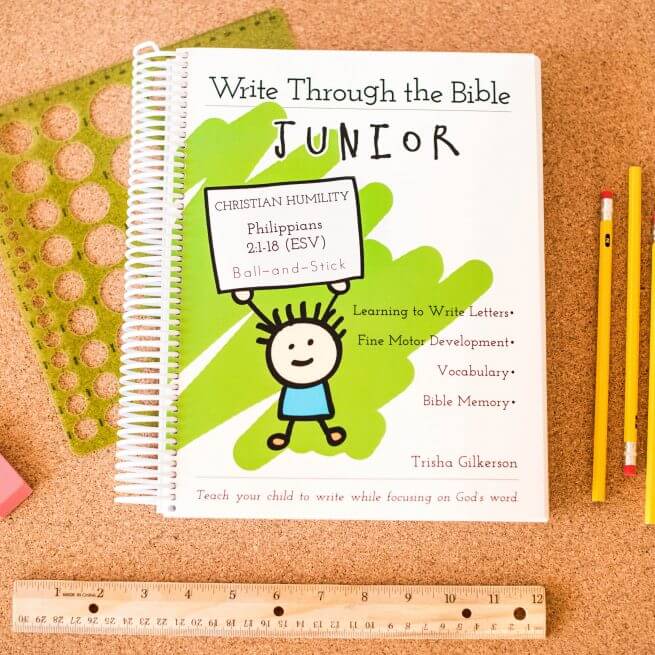Improving handwriting is no small task for the sloppy writer.
To this day, I wish we had done more with our oldest son to improve his handwriting when he was younger. My second-born kiddo really takes pride in his penmanship; my youngest are still learning. But my oldest makes pencil strokes on the paper like Zorro carving initials into his defeated foes.

But I’ve learned through trial and error—and some research—some tips on how to improve handwriting if your child is struggling to write legibly.
Handwriting skills are a very important developmental task for kids. Improving handwriting is an important aspect to a child’s education—whether you are a homeschooling parent or a parent of a child in a school where he/she is coming home with warning slips about poor writing skills.
Even with the increase in technology, a child’s penmanship is still very relevant. Good handwriting is linked to…
- Reading skills
- Verbalization
- Creative thought
- Fine-motor skills
First Step: Identify the Problem
The first step to helping your child improve handwriting is to identify the problem(s). Some common handwriting problems include:
- incorrect pencil grasp
- poor letter formation
- improperly sized letters
- lining up the words correctly
- incorrect spacing between words
- poor pencil pressure
- inconsistent upper and lower case writing
You can only help your child improve their handwriting when you can identify their biggest challenges with writing. By identifying their specific problems, you can focus on the exact practices to start with them to bring huge improvement to their handwriting skills.
How to Improve Handwriting
Once you identify the specific problems, you can hone in on what to do for your child to help them improve handwriting.
Here are some general tips for improving handwriting that you can modify for your specific child’s needs.
1. Practice Properly Gripping the Pencil
One of the biggest ways to improve handwriting is by focusing on the pencil grip. This is often the main reason why a child’s handwriting can suffer.
Watch your child write and look for the “tripod grasp,” which is using the thumb, index finger, and middle finger to hold the pencil, not a closed fist. The thumb should be bent, with the index finger on the opposite part of the pencil and the middle finger on the side of the pencil.
Make sure they are not holding onto the pencil too tightly. You should also watch the pressure they use when they are writing with this “tripod grasp”. If they are using too much pressure to write, it can not only make it more difficult for them, it will tire them out quickly.
If your child struggles with pencil grip, you can try different pencil grips that attach to the pencil to help with proper finger placement. You should always address the underlying pencil gripping issues first, but a pencil grip can help reduce fatigue and muscle cramps and help them practice properly holding a pencil.
2. Use Good Writing Tools
Some of the best writing tools to improve handwriting is using the right type of paper.
Use handwriting sheets that have tracing lines and words to trace to help your child build their handwriting confidence.
You can also use lined paper to help your child improve their handwriting. Lined paper can help them learn proper letter sizing and how to keep their words straight.
Finally, make sure to provide your child with the proper sized pencil for their age, and don’t forget to get a pencil grip if you think that is necessary.
Have your child practice using lined paper and look at their handwriting for the following issues:
- Are the heights of the various letters proportional? Are the capital letters and lowercase different in size?
- Are the letters staying between the lines, or are they going over the top or bottom of the lines?
- Are the letters showing properly closed loops? For example, look at the ‘c’ and ‘o’ letters and make sure you can tell the difference.
- Are there dotted “i’s” and crossed “t’s”?
3. Practice Slowing Down
One of the common reasons for poor handwriting is when a child tries to write too quickly. For many children, simply practicing slowing down and being more aware and deliberate about each movement of the pencil can help solve many handwriting issues.
Getting the right pace for writing is important. First, learn your child’s current pace for handwriting. Some children take a long time and others rush through it. Teach your child how to make a consistent pace for writing.
Make sure you take your time with fixing the pace of their writing. They cannot get better at the writing pace overnight, and it is important to have patience with the writing pace so that the child does not feel overly stressed about it.
If your child is becoming distracted or tired, make sure to give them frequent breaks as you practice slowing down and learning a proper pace for handwriting.
4. Be Positive and Reduce Pressure
Nagging or arguing with your child about handwriting will not help them learn how to improve handwriting quicker. Instead, it will just stress your child out and make handwriting a stressful situation. Set the stage for improvement with a positive attitude.
Praise them for the handwriting skills that they do correctly. If they struggle with writing in a straight line, but they always keep the correct proportions for the letter sizes, make sure you praise the good while gently instructing with the things they need to still improve.
Reduce the pressure for your child and remain patient and calm. Rushing a child towards perfection in handwriting will not help. If you find yourself being more and more negative while helping your child improve handwriting skills, simply take frequent breaks while practicing, for the benefit of both you and your child.
5. Build Muscles in the Hands and Arms
Since writing uses the muscles of the hands, arms, wrists, and fingers, practice fine motor skills to improve these muscles to help with writing endurance. Increasing strength and dexterity can help your child have more control over the pencil and help them not tire out as quickly.
There are many non-writing activities your child can do to help strengthen fingers, wrists, hands, and arms for better handwriting:
- Cut items with scissors
- Use a screwdriver
- Sewing and knitting
- Stringing beads
- Coloring
- Using play dough
- Playing Jenga, Operation, or other hand-coordination family board games
- Sports
6. Make Handwriting Practice Purposeful
Practicing handwriting does not have to be strict and boring for your child. With a little creativity, you can sneak in handwriting practice that is fun to help keep them interested.
Here are some ways to make handwriting practice more fun:
Connect handwriting to another school subject—like Bible memory. Write Through the Bible workbooks provide a year’s worth of handwriting practice while immersing kids in Bible memory.
- Use different colored pencils or colored paper for artistic variation to handwriting practice. You could also give them fun pencil toppers and other writing accessories.
- Use different writing surfaces instead of paper. This can include writing in: foggy mirrors, shaving cream, sand, mud, etc.
- Use word puzzles and other games like anagrams, hangman, connecting the dots, crossword puzzles, etc.
- Have them make bucket lists or gift lists. Sneak in some writing practice by having your child write down lists of places they want to see or gifts they would like for their birthday or Christmas.
- Teach handwriting through art class. Drawing and painting are good ways to practice proper grip while making practice more creative and fun.
- Encourage them to read more books. Reading can improve writing by letting your child see neatly printed and proper letters on the page.
Final Words: Improve Handwriting with Practice and Patience
Handwriting is a skill that needs both practice and patience. You can help improve handwriting skills for your child by staying calm and encouraging. The more your child writes, the better he/she will get at it. Try to make it interesting and fun whenever possible to help your child stay relaxed and interested in the subject matter.
Write Through the Bible
Since 2013, we’ve been creating simple workbooks for kids that combine Bible memory and handwriting practice into one daily activity. Write Through the Bible workbooks have been used by thousands of Christian parents for kids of all ages:
Junior: for kids just needing to learn their letters and letter sounds
Intermediate: for kids ready to start writing short phrases and sentences
Mastery: for kids ready to need continuing handwriting practice
We have many Bible passages to choose from. Learn more about Write Through the Bible workbooks.













Leave a Comment